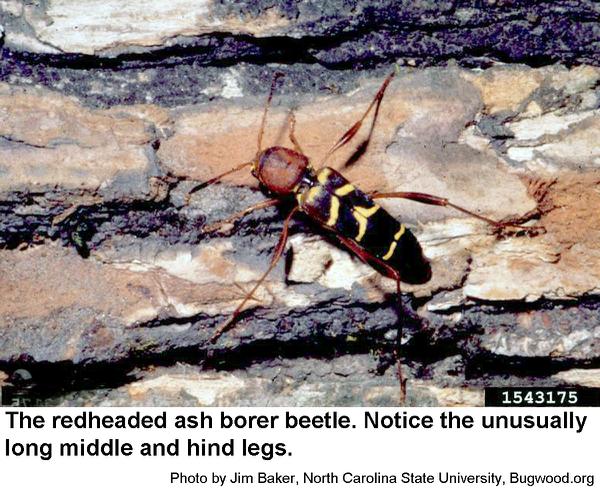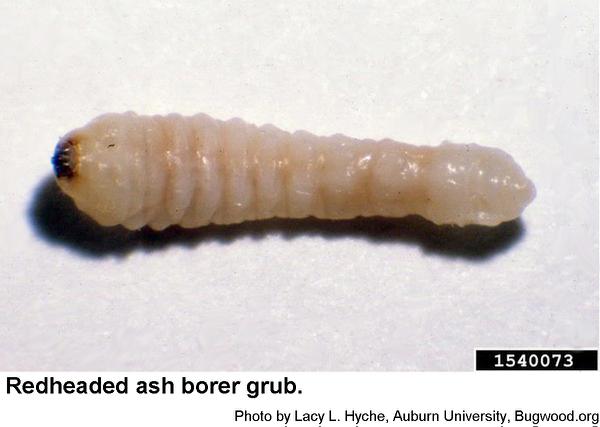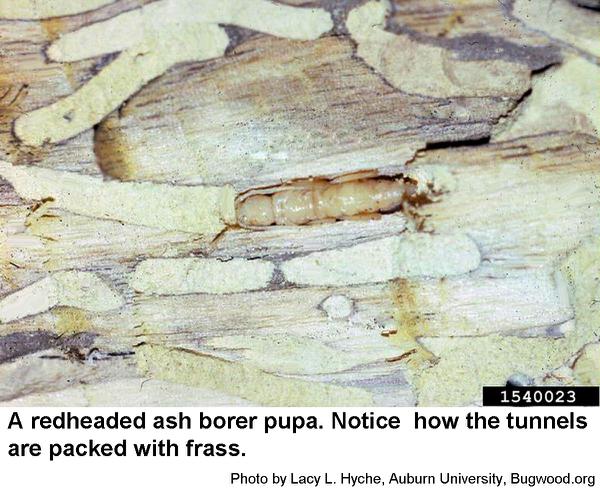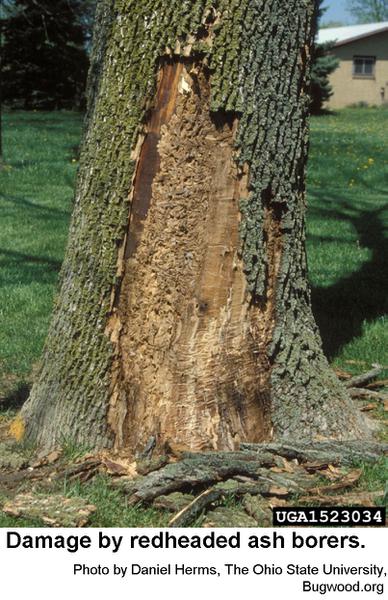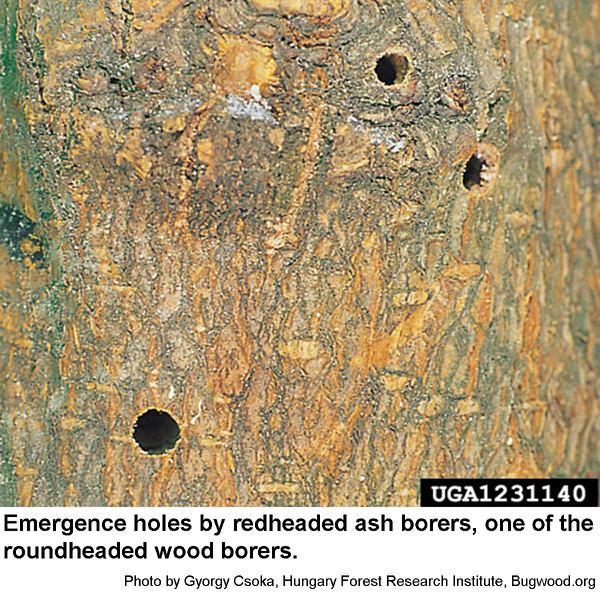Description and Biology
Redheaded ash borers, Neoclytus acuminatus, breed in newly planted living trees and dying or dead hardwood trees and even felled logs that still have the bark intact (debarked logs are safe from this beetle). These relatively slender beetles are 1/2 to 5/8 inch long and have reddish heads and thoraces. The wings are dark and are crossed by four narrow, yellow bands. The two middle bands are chevron-shaped. The middle and hind legs are noticeably long and reddish. The antennae are about half as long as the body. The grubs are pale and legless and eventually grow to almost 1 inch long. This insect spends the winter inside a host tree probably in the pupal stage. Adult beetles emerge as the weather warms up in spring and are active until the weather cools off in autumn. Females chew notches in bark and lay their eggs under the bark. The newly hatched grubs feed on the sapwood and later tunnel into the heartwood and may turn the heartwood almost completely into powder. We have two or three generations per year in North Carolina. These borers may emerge from firewood kept indoors. There they are harmless but can be a nuisance.
Host Plants
Redheaded ash borers can attack nearly all dying and dead hardwoods, but seem to prefer ash, hackberry, hickory, oak, and persimmon. Fruit trees and even grape vines may be attacked. Unseasoned logs of ash, hickory, and oak with the bark intact are especially attractive. In saplings, the larvae work in the inner bark and summer wood both horizontally and vertically through the trunk. Infested trees may break off during high winds.
Residential Recommendations
There is no control recommended for redheaded ash borer larvae already inside living trees. Permethrin or another pyrethroid can be used to prevent further infestation by this pest if an infested tree is still sufficiently alive to try to save. When used as directed, pyrethroids are very toxic to insects but are not particularly hazardous to humans and pets (other than fish-avoid using pyrethroids around pools, ponds, and streams). Not much more that can be done other than prune out dead and dying branches, mulch, water during dry spells, and perhaps fertilize and lime ACCORDING TO A SOIL TEST. Fertilizer should not be applied without guidance because too much nitrogen can make trees even more attractive to borers. For example, redheaded ash borers are sometimes pests in young nursery stock where the saplings receive plenty of water and nitrogen.
References
- Redheaded Ash Borer, Neoclytus acuminatus. Anonymous. No Date. Information on Insects/Arthropods and Plant Diseases. Digital Diagnostics. Entomology and Plant Pathology, Oklahoma State University Extension Publications.
- Redheaded Ash Borer, Coleoptera: Cerambycidae, Neoclytus acuminatus (F.). Dellinger, T. A. and E. Day. 2015. Virginia Cooperative Extension, Virginia Tech, Virginia State University.
- Redheaded Ash Borer Also a Threat to Ash Trees. Shour, M. 2008. Iowa State University Extension and Outreach, News.
- NC State Extension Plant Pathology Publications and Factsheets
- NC State Horticultural Science Publications
- North Carolina Agricultural Chemicals Manual
For assistance with a specific problem, contact your local Cooperative Extension center.
This factsheet has not been peer reviewed.
Publication date: Sept. 29, 2017
Reviewed/Revised: Oct. 11, 2019
Recommendations for the use of agricultural chemicals are included in this publication as a convenience to the reader. The use of brand names and any mention or listing of commercial products or services in this publication does not imply endorsement by NC State University or N.C. A&T State University nor discrimination against similar products or services not mentioned. Individuals who use agricultural chemicals are responsible for ensuring that the intended use complies with current regulations and conforms to the product label. Be sure to obtain current information about usage regulations and examine a current product label before applying any chemical. For assistance, contact your local N.C. Cooperative Extension county center.
N.C. Cooperative Extension prohibits discrimination and harassment regardless of age, color, disability, family and marital status, gender identity, national origin, political beliefs, race, religion, sex (including pregnancy), sexual orientation and veteran status.

